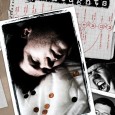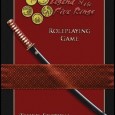 GM: Sean Nittner
GM: Sean Nittner
Players: Brent Sturdevant, Jon Edwards, Noam Rosen, and Shaun Hayworth
System: Mouse Guard
I ran my Mouse Guard game (which I had run my play test for a few weeks ago. AP report for that here) at Good Omens Con on Saturday evening.
I had four awesome players in my group. Brent Sturdevant, Jon Edwards, Noam Rosen, and Shaun Hayworth. I had gamed with all but Jon, but as it turned out he is running a Mouse Guard game of his own and so was already familiar with the system and setting. This meant I had all my players pouring a ton of creative energy into the game. As I’ve said many times before, the thing that makes a great game is great players, so I knew I really couldn’t go wrong.
That said, I was pleased with the game but also frustrated by my lack of proficiency with the system. My group needed very little prompting to run with the story and yet if felt that my implementation of the rules reined them in more than it encouraged them to blossom. In the end I think there was too much GM time and not enough player time. I’ll break that down more below.
I’m not going to give a recount of the actual game because frankly, even with the minor frustration above I had a blast running it and I want to run it again. I’m going to review the warm up exercises and then jump right into the pros and cons of the game.
Introduction
I started by thanking everyone for being in my game and I think for the first time I had a table of players who all thanked me for running it (that was cool). I told them we would be doing some warm up exercises that would help us get into the mood of the setting, learn the rules and establish the back story for our characters.
That last one was really a selling point. In the discussions with Willem and Jason (posted about over here) and on the Myth Weaver’s episode, one thing we all have discusses is player buy in. Sure, you’ve got these great games to get people warmed up for the game but you don’t (as a GM) want to make the pedagogy of play a pain. It should all be part of a whole expereince so that it naturally transitions into the game as published by the author. I took some advice from Willem by starting the game announcing my intent and making sure the players at least tacitly agreed. Most gave me somewhat neutral responses except for Jon who was feverishly taking notes. I got the impression they were all saying “Cool, lets see where this goes.”
Mouseball
Our first game was Mouseball, derived from an improv and team exercise “Soundball.” We had a little plush Liam that we tossed around spouting off things a mouse would encounter. We did what mice fear, what they like, what they eat but really got rolling when we talked about what mice hide in. The answer was apparently LOTS of places.
Epic Journey
The next game was the Epic Journey describing the trials and tribulations of the old guard (characters who were mentors to the cast of characters played). I read the quote “Send any mouse to the job and it may or may not be done. Ask the Guard to do the task, even death cannot prevent it from completion.” I explained that this has a real “in game” effect that a mouse of the guard never fails to achieve his goals, he just faces complications around the way. I reviewed the twist and condition results and then we got to telling a story.
This introduced a lot of mechanics. One player would draw a mentor to play and the player to his left would draw an obstacle card (Animal, Weather, Wilderness or Mice) and then present an obstacle. Based on the skills I knew the characters had I would tell them what skill to use and what the Obstacle was. We started with a single roll using only traits. Since this roll failed I then introduced a twist. The next roll involved a skills, traits and teamwork and as it failed I introduced a condition. The next roll introduced wises to the mix, etc. With each roll we built on the mechanics and the story of the Mentors.
Group Conflict
I read the motto “It’s not what you fight; it’s what you fight for” and we jumped into a fight that the Epic Journey had been building up to. Fights are the easiest conflicts to explain because the weapons are on the conflict sheet and all the actions make intuitive sense (Attack, Defend, Feint and Manuver). Once the Goals were written and disposition was rolled I asked each character to Narrate a bit of awesomeness that had done, then I did the same for their opponents and then I told everyone to cut their disposition in half, rounded down.
The reason for this is that a) conflicts can go long and I didn’t want to drag this one out, b) I wanted to make sure the players were familiar with making concessions and c) I wanted the “Defend” maneuver to be immediately useful (which is generally isn’t when you are at full disposition). The conflict was bitchen and the results really charted the game from then on. We got more practice using skills, wises, teamwork and traits. We also introduced conflicts, fate, persona and compromises.
I See
Probably my favorite game, though not one that engaged the system much was “I see.” Each player picked a character and then was handed three stickers with traits on them. The player went around the table assigning each other those traits, which were stuck to the character tents for all to see. Why is it that everyone makes Dain the fat one? Hard to say. This process we talk about how the traits could be used to help or impede the mice and what the benefits of that are.
Accomplishments
The last exercise was “Accomplishments.” This was probably my least favorite. I gave each mouse a trial they had to face with the aid of a single other mouse. It was really an arbitrary test with the goal of giving them a meaningful challenge to form a belief around.
This introduced beliefs and skill advancement as well as reiterating the olds stuff, plus gave them a chance to earn more player checks by impeding themselves (as they had previously been playing their mentors so we didn’t track the checks they earned). I’ll talk more about this below. It introduced some important things, but of all of the exercises this one felt the most GM directed and exhausting for me. This might work better if I prepare the accomplishments in advance but I’m thinking about dropping this all together.
Then we proceeded to the first GMs turn and the Mouse Guard kicked some butt and took names. Details on this part will be revealed in another post when I finally put this adventure to bed.
What rocked
As I said before my players were awesome. They really brought the game to life and made it a joy to run.
The props were so worth it. I put a ton of energy into preparing them and loved it every time I handed one to a player. I’ll take some pictures of them and then post those up in a separate post.
I started catching on (remember me talking above about lacking proficiency myself) that the cool way for the players to take more narrative control during the GMs turn was for them to earn two checks and then spend them to take an action I hadn’t previously described.
Some of the twists were just a blast to play out. The first one in particular was a lot of fun, I’m glad it came out both in the play test and in the con game.
The finale was not at all what I expected and probably not something that will ever come out again. It was a total blast and felt like the perfect merging of fiction and mechanics, with both of them reinforcing the other.
What could have been improved
In the Epic Journey I encouraged people to use traits to impede themselves but had no good way of rewarding that as we didn’t have a Players Turn following the Epic Journey. Maybe I need to treat the Accomplishments as a Player Turn so as to introduce that as well and reward them for impeding the mentors. Also, during the Epic Journey I didn’t give an explicit goal for the mission. I think if I did that it woudl be easier for the players to frame obstacles for each other.
The accomplishment felt oddly out of place. I like the idea of the characters playing themselves as younger mice earning their cloaks, but I want to put it more in their hands. I think next time I will treat it like a Players Turn and let them tell me how they earned their cloak and take a test accordingly. Also, this would give me the option to use twists again to have a second mouse bring in their accomplishment as part of the twist if the first roll is failed. Either way, putting more control in the hands of the players would be good at this state. Much of the rest of the game, I have a very heavy hand.
I had players wanting to do a lot more than the GM turn called for. I mitigated some of this through narratives (“cool, describe how you do that”) that were not tests and then (as pointed out above) figured out that if they really wanted to have a mechanical impact, I would encourage them to build up player checks so they could take the actions they wanted during the GM turn. Still, I did feel that I had to stifle the players some. Some of this follows the conceit of the game; the Guard isn’t free to do as it wishes. Some just felt artificially biding.
Overall, many thanks to the players for making the game so much fun for me to run as well as for your fellow players to be in. As I will probably try to run this at Game on Demand at GenCon please let me know if you have any suggestions for making it better. I’d love to hear them.


Pingback: Pedagogy of Play